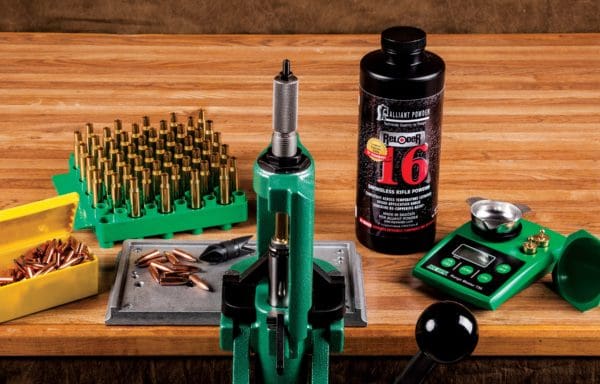
When I first dipped a toe in the reloading pond, I started by concentrating solely on rifles, specifically bolt guns. At this point, I see no reason to stray as I don’t shoot the volume to justify a handgun- or shotgun-loading habit, and my accuracy in both categories certainly hasn’t exceeded the capabilities of modern factory loads.
That’s not to say my rifle shooting prowess has exceeded the capabilities of factory match ammo either, but occasionally I want to push a projectile that isn’t loaded from the factory or tweak a factory load to shoot a bit better in my rifle of choice.
The first lesson imparted to me upon going down this path was that Hodgdon powders were the gold standard, and that if it couldn’t be done with Varget or H4350, it might not be worth doing. Furthermore, I was advised to ignore the siren song of the Alliant RL powders as their extra “oomph” came at the expense of wild swings in velocity and pressure based on ambient temperature.
The first part of that advice has served me fairly well, and I still stock up on both whenever I find either of those powders, but a press release from Alliant piqued my interest by specifically contradicting what I’d heard about the RL powders.
RADFORD, Virginia — August 18, 2016 — Alliant Powder, a leading manufacturer of smokeless powders, offers consistent long-range accuracy across temperature extremes with the release of its new Reloder 16 rifle powder. Shipments of Reloder 16 are being delivered to dealers now.
Reloder 16 utilizes TZ technology, which manipulates the response of the propellant and resists the natural tendency to generate more pressure at higher temperatures and less pressure at lower temperatures. As a result, Reloder 16, similar to Reloder 23 and AR Comp, offers world-class stability. The powder has excellent lot-to-lot consistency and contains a proprietary de-coppering additive without any DNT or DBP.
The Reloder 16 burn rate is slightly faster than that of Reloder 17, well within the 4350 burn speed band. This makes the new powder ideal for traditional hunting cartridges, such as 30-06 Spring. and 270 Win., as well as 6.5mm target loads and tactical applications wherein temperature stability is required.
At the time, I had Bergara’s 6.5 Creedmoor chambered B-14 Woodsman on test which seemed to be just the test mule for this sort of thing. A quick swipe of the Visa and several hundred Berger 140-grain VLD Hunters were winging their way towards Texas. Add in a passel of once-fired Hornady brass and some CCI BR2 primers and I had the beginnings of a fun couple nights in the shop.
At the time of this test, I had yet to see the light and discover the myriad benefits of ladder testing, so I loaded up various charge weights, shot for five-shot groups, and attempted to dial in a load that I liked.

While I’m admitting errors, I didn’t end up writing down the final load, but I believe it was that 41.8-grain weight you see above at a base to ogive length of 3.160 inches which corresponded to about .020 inch off the lands. The data that Alliant sent over for a 140 Sierra Game King indicated that 43.8 grain was the maximum charge. I didn’t want to use this rifle like a test case, so I came down quite a bit in my testing and used 42.4 grain as a max load. I didn’t see any pressure signs at that personal maximum charge but accuracy did start to suffer. As I was looking to test temperature sensitivity first and foremost, I didn’t spend much time chasing tenths focusing instead on a load that was hunting accurate and safe.
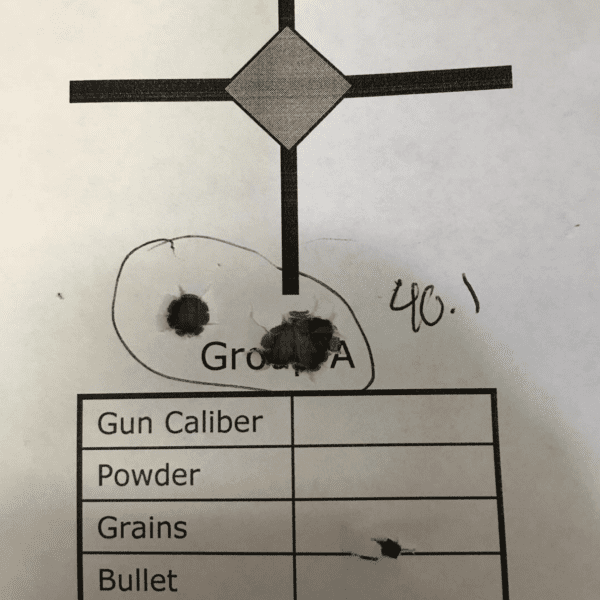
I performed a similar load workup with H4350 and found a bughole load, seen above, at 40.1 grains, –.6 grains under Berger’s suggested maximum charge. Again, no pressure signs and a real winner as far as accuracy was concerned. Clumsily, I lost my H4350 load workup targets, but my memory was that the groups were slightly better with H4350 than they were with RL-16. Most of my load workups with RL-16 hovered at 1.5 MOA or better where the ones with H4350 seemed to hover around 1 MOA.
With sub-MOA loads for each powder identified, I loaded up 50 rounds each with H4350 and RL-16, fired up my vacuum sealer, and got to work creating some watertight ammo packages with 10 rounds each. Once that was done, I headed out to the family ranch — the only place I have access to with 110V outlets in close proximity to a safe backstop.
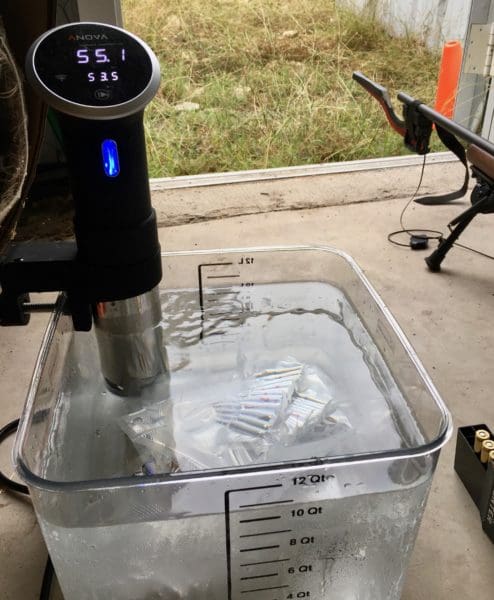
I decided to test each bundle of loads at five temperature ranges that were evenly spaced and covered the sort of conditions I might find in Central Texas during the course of a typical hunting season. I elected to go with 20, 55, 75, 95, and 120 degrees Fahrenheit as my testing points. Luckily, the day I picked to do this had ambient temps hovering around 60 degrees, so the 55-degree point was the only one that required any management on my part.
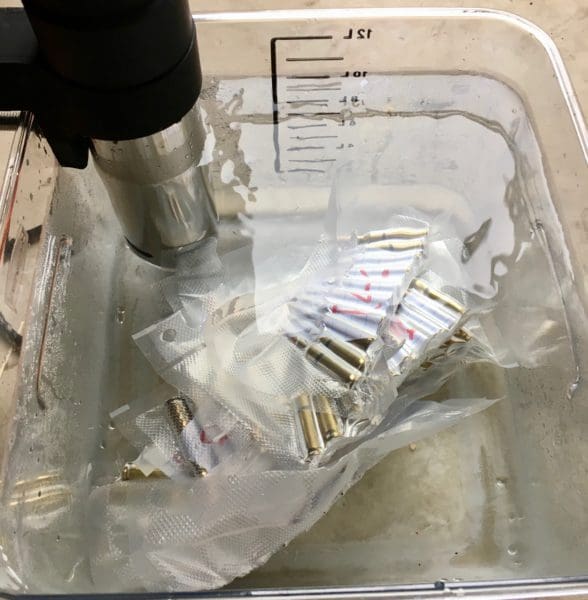
For the 20-degree data point, I let both bundles marinate overnight in the family freezer so they were good and chilled by the time I was ready to test. For the rest, I immersed them in a bucket of water, and used an Anova Precision Cooker to regulate the temperature for the remaining data points. The 55-degree one required that I maintain things with ice chips a bit, but I was able to reliably hold the temperature plus or minus one degree.
My testing protocol was to allow the gun to assume ambient temperature and shoot all 10 rounds as fast as possible loading directly in the action without any time for the cartridge to warm to the the rapidly heating rifle. Each bag of loaded ammo was allowed to come up to the test temperature and then held for a minimum of 20 minutes before being tested. Velocity data was recorded using a barrel-mounted MagnetoSpeed v3. I did not clean the barrel during the duration of the test and tested in the following order:
- H4350 @ 55
- RL-16 @ 55
- RL-16 @ 75
- H4350 @ 75
- H4350 @ 95
- RL-16 @ 95
- RL-16 @ 120
- H4350 @ 120
- H4350 @ 20
- RL-16 @ 20
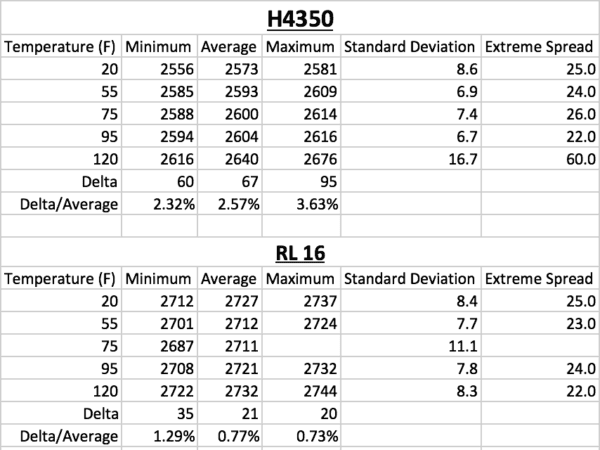
When the smoke cleared, I was pleased with the data that had been collected, the lack of holes in my body, and the fact that none of my reloads had blown up. The barn cat was nowhere to be found, not surprising given the amount of indoor gunfire he’d been exposed to throughout the course of the day.
What I found was that over a 100-degree temperature spread, the average velocity from my H4350 load varied by 67 fps from minimum to maximum. There was a nice flat band from 55 to 95 degrees where the average velocity differed by 11 fps with extreme spread over 30 rounds of 31 fps. That’s really consistent performance, in line with what the market expects from H4350. However, one either side of that band velocity deviated quite a bit. Where most of my loads had single-digit SD values and extreme spread below 30 fps, the 120-degree load had a SD 16.7 and extreme spread of 60 fps. That leads me to believe that moving much beyond 120 degrees would see dangerous pressure spikes. But 120 degrees is about the hottest I’d ever want to be out hunting anyway.

RL-16 was far and away a success on the temperature sensitivity front. Across 100 degrees and 50 rounds, the average velocity only differed by 21 fps. Oddly, the coldest load was 15 fps faster than the 55-degree load. I’d be inclined to chalk that one up to a dirty and fouled barrel had the H4350 load not performed the oppostie way. Similar to the H4350 loads, I saw single-digit SD values across the board with the exception of the 75-degree load which was at 11.1. I made a mistake copying numbers from the MagnetoSpeed and did not record the maximum value for that load as well. Unlucky I guess!
More interesting was that the RL-16 loads were 92 to 154 fps faster than H4350. In the middle band from 55 t0 95 degrees, the velocities were 111 to 119 fps faster than H4350. At the 600-yard line in my local area with the 75-degree load, 111 fps is worth an extra .3 mils (7.5 inches) of elevation which just might be the difference between a hit or a miss.
Specifications: Alliant Reloder 16 Powder
Available Sizes: 1 lb and 8 lb
Principal Purpose: Medium Rifle
Secondary Uses: Short Magnums
Load Data: Available Here
Price: $26.99 (1 lb) or $194.99 (8 lb)
Ratings (out of five stars):
Temperature Sensitivity * * * * *
H4350 is the long reigning king of temperature stability and is the go to choice for nearly ever reloader I’ve met who is loading for .260 REM or 6.5 CM. RL-16 is very temp stable and flat out stomped H4350 with lower absolute variation in average velocity and given the 100+fps gain in velocity, smaller deviation in variation as percentage of the average velocity.
Velocity * * * * *
The RL series of powders have always been known as speed demons, and the reason that many reloaders deal with the potential for temperature sensitivity is because the RL powders are FAST. RL-16 held up the reputation by delivering 92-154 fps more velocity at two grains under max against my H4350 load that was .6 grains under the listed max. If you’re looking to make them scream, RL-16 is very likely going to make you happy.
Accuracy * * * *
Generally speaking, I felt like my H4350 loads were a bit more accurate, but I really didn’t spend a lot of time chasing tenths. Both powders were able to produce multiple sub MOA 5-shot groups, which was plenty fine for my uses. If Alliant wants to ply me with more components, I’ll definitely chase accuracy.
Overall * * * * *
I was skeptical going into this test figuring that Alliant Powder Reloder was all talk. What I found through the most scientific test I could put together at the time was that RL-16 produces faster velocities at well below max charges with much less variation in velocity when exposed to a broad range of temperatures. At $27/lb, it is right in the ballpark of H4350 and gives reloaders another option for powder.
More from The Truth About Guns:
From Alliant Powder: Improved Red Dot and Green Dot Powder
Accuracy Testing Your Rifle — Excerpt from ‘Gunsmithing: Rifles, 9th Edition’


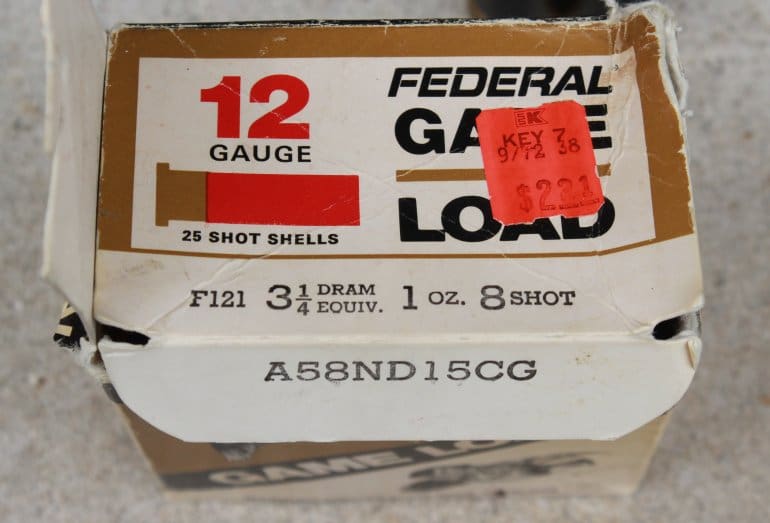

“At this point, I see no reason to stray as I don’t shoot the volume to justify a handgun or shotgun loading habit…”
Which is pretty much what every junkie has said at some point before they moved to the needle.
That is absolutely the funniest thing I have heard all day! Thanks for the laugh.
Been a’ reloading for rifle & pistol since 1966. Started with Hodgdon BALL (spherical) powders, due to their consistency through powder measures. Never found any reason to change, except to another Hodgdon ball powder.
I only reload with black powder at this point, but I have looked at the shelves of all the different powders and said to myself, “How do I know which one to use?” My Lee Loader lists six different powders for .45 Colt cartridges, and I pretty much throw up my hands, not knowing which is best (except that Universal is universal for all bullet weights) and not wanting to devote a significant sum to testing each and every one. So maybe powder testing could become a feature here, eh?
Honestly that depends on what powders you have and what you’re looking to do. As an example, I have the following powders I’d load .357 magnum with in my stash:
H110
Blue Dot
Unique
Bullseye
Titegroup
H110 is only good for absolute maximum loads. This powder is very intolerant of under loading, in fact it can blow your gun up if you run reduced loads.
Blue Dot is kind of in between. It definitely has quirks too and isn’t quite as hot as H110 in .357 but it is hot. I can load .357 with it but prefer to load hot 9mm with it. If I’m going to load hot in .357 I’ll use H110.
Unique is a bit faster than Blue Dot, but slower than the “target” powders below. This is an awesome all around powder, I’ve loaded this full bore to loads that’d make a 22lr feel like a heavy hitter.
Titegroup and Bullseye have a faster burn rate than either Blue Dot or H110. They’re meant more for lighter target loads. I got the Titegroup at a good price. In terms of loading I prefer Bullseye though, just because it seems to be more accurate in my wheel guns.
There is definitely some experimentation involved, but another point of advice I’ll give is the Lyman manuals tend to give an indication of the “most accurate” load in their testing. If you want more horsepower at the expense of accuracy more power to you. 🙂
Honestly in my .357 if I use a basic cast bullet with Bullseye it’s more accurate than Remington factory .38 practice ammo at about 1/4 the cost. I’m sure that .45LC is the same way. Anything other than the “dirt common” rounds like 9mm and 223 can get economy reloading especially with cast bullets in handgun calibers.
Thanks. It is comments like yours that assist in choosing a powder without spending a whole lot of money and ending up with pounds of powder you don’t want.
The Lyman sheet that came with the Loader lists Universal, IMR 800X, SR 7625, IMR PB, and Clays, plus Bullseye, Unique and Power Pistol for 230 gr. XTP bullets. I prefer to load lead because they can be crimped, and thus easier to maintain minimum OAL. Nor do I need to spend a bunch of money on HPs for target shooting.
I reload 4 gauges and I will testify to the junkie nature of all of this
I really like Alliant R7 for .45-70 loads. Technically, it’s for very small rounds, but it does a bang up job pushing 405 grains of screaming death.
This is really interesting, I’m a huge fan of Alliant powders and have had really good success with their Power Pro line in my heavy 308 loads. I’ve found myself trying different powders more recently, because I too was beat over the head with the supremacy of H powders by my my reloading sensei, so it is really good results to see given how hard it is to find Varget and H4350 sometimes. Its an added bonus that you were seeing better velocity at safer charge levels too. I will definitely have to try some of this in my 6.5 Creedmoor.
Also, thank you for using the correct name of Reloder (with no “a”). It’s a pet peeve of mine when people cant be bothered to pay attention to the way the manufacturer spells/pronounces their product name.
Hot Dang! It’s a lot easier to find RL-6 than H4350, so I figure this is good news.
Good stuff Tyler. I was eye balling a decent selection of powder yesterday, with a close look at the Reloader selection. That increase in velocity without pressure signs is very interesting. My .308 likes 168 SMK’s pushed to 2650 fps using 4350, but the crappy extractor on the Savage likes to eject itself after around 20 rounds.
I may try a pound.
Tom, for your 308, grab a pound of Alliant Pro2000MR, CCI BR2 primers, and load somewhere in the 46-47gr range under a 185gr Berger VLD, you won’t be disappointed.
It may be pistol, but I’ve had extremely consistent “feel” when it comes to using 2400. I pretty much reload 357 mag exclusively with 2400 and have shot it from 100 degree to 0 degrees with no noticeable difference in “feeling”. I do not however load light loads with it, I’m either shooting max loads or slightly less at 14.7grs +/- .1 gr.
Its given excellent performance in a friend’s 30 carbine as well.
Quite relevant and informative test. I load both powders with other like components for both, the 6.5 Creedmoor and 260 R.E.M. Your results overall are consistent with my experience. Regarding accuracy, however, both RL-16 and H4350 produce sub 0.5 MOA in my rifles, which include factory and custom built bolt actions. I have noticed that H4350 seems to have a smaller/finer grain size which seems to flow better than RL-16 in the handloading operation. And finally, the availability of RL-16 has been much better than the H4350, but more recently I have found RL-16, somewhat more difficult to locate.
Thank for your efforts!
Comments are closed.